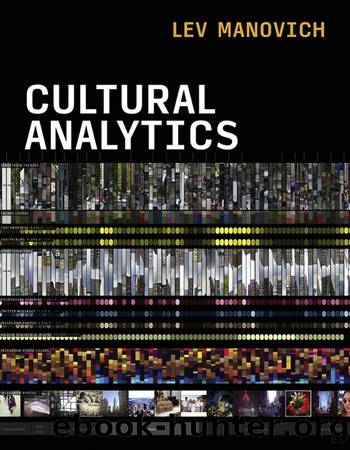Cultural Analytics by Lev Manovich

Author:Lev Manovich [Manovich, Lev]
Language: eng
Format: epub
Tags: distant reading; informatics; data science; humanities; semantic web; aesthetics; visual culture; machine learning; computer vision; predictive analytics;
Publisher: MIT Press
Published: 2020-09-29T00:00:00+00:00
Measuring Perceptions
Modern art of the last sixty years is one of the cultural areas that presents a challenge for cultural analytics methods. What about other cultural expressions that exploit three-dimensional textures, transparency, volumes, and our senses of touch, taste and smellâfor example, fashion, perfume, food, architecture, and space and object design? I have already discussed the challenges of capturing in numbers the experiences of seeing or wearing many fashion items that work with dimensions that canât be easily read from fashion photographsâvolumes, structures, differences in material surfaces. This is how Hadley Feingold describes a famous dress from Hussein Chalayanâs 2000 spring/summer collection in her post âSculptural Fashionâ: ââRemote Controlâ (often referred to as the Airplane dress) . . . is made of fiberglass and resin composite and has flaps that open via remote control. What is revealed beneath is a soft mass of tulle. What is truly striking here is the modular fabrication, at once sleek and impersonal, that opens up to a soft, more human-like interior that is at the same time no less structured.â23
How can we capture as data at least some of the unique characteristics and subtle differences in numerous designed products and experiences? Think of descriptions of new perfumes, cars, or drinks offered to consumers: here writers employ adjectives, historical references, and metaphors. Now think of the product development, marketing, advertising, and other departments of companies that make and offer these products in many markets. They perform user studies by employing questionnaires, focus groups, in-depth interviews, ethnographic methods, self-reports; they analyze peopleâs behaviors and interactions with brands and ads on social networks using interaction data; they capture biometric and brain activities using a variety of techniques ranging from hear rate measures to fMRI.
Many techniques used in consumer marketing research, advertising research, and brand management are the same as in sociology, anthropology, human-computer interaction, political science, and especially psychology. In all areas, methods such as surveys, questionnaires, and physiological recordings are used to quantify aspects of human experiences and human understanding of themselves, other people, products, and situations. These methods compensate for our inability to directly measure human cognitive and emotional processes and states. For example, rather than using some objective measurements of pain, a doctor asks you to characterize your experience of pain on 1â10 scale. (In 2013, researchers were able to successfully measure levels of pain using fMRI, but given its cost and equipment required, you will not see this method in a regular doctorâs office today.24) Over time, new technologies and improvements in existing ones gradually improve our ability to directly measure such states, but this is a slow process.
What does this mean for cultural analytics methods? Instead of measuring cultural artifacts, we can instead measure human perceptions and experiences of these artifacts and our interactions with them. In this paradigm, human experience becomes the common denominator that allows us to bypass the challenge of measuring multisensory or ephemeral offerings. To do this, we can rely on methods used in HCI,25 marketing research, attitude
Download
This site does not store any files on its server. We only index and link to content provided by other sites. Please contact the content providers to delete copyright contents if any and email us, we'll remove relevant links or contents immediately.
Algorithms of the Intelligent Web by Haralambos Marmanis;Dmitry Babenko(9832)
Azure Data and AI Architect Handbook by Olivier Mertens & Breght Van Baelen(7611)
Building Statistical Models in Python by Huy Hoang Nguyen & Paul N Adams & Stuart J Miller(7593)
Serverless Machine Learning with Amazon Redshift ML by Debu Panda & Phil Bates & Bhanu Pittampally & Sumeet Joshi(7478)
Data Wrangling on AWS by Navnit Shukla | Sankar M | Sam Palani(7238)
Driving Data Quality with Data Contracts by Andrew Jones(7233)
Machine Learning Model Serving Patterns and Best Practices by Md Johirul Islam(6964)
Learning SQL by Alan Beaulieu(6211)
Weapons of Math Destruction by Cathy O'Neil(6143)
Big Data Analysis with Python by Ivan Marin(5883)
Data Engineering with dbt by Roberto Zagni(4899)
Solidity Programming Essentials by Ritesh Modi(4529)
Time Series Analysis with Python Cookbook by Tarek A. Atwan(4359)
Pandas Cookbook by Theodore Petrou(4057)
Blockchain Basics by Daniel Drescher(3507)
Natural Language Processing with Java Cookbook by Richard M. Reese(3100)
Hands-On Machine Learning for Algorithmic Trading by Stefan Jansen(3027)
Feature Store for Machine Learning by Jayanth Kumar M J(2908)
Learn T-SQL Querying by Pam Lahoud & Pedro Lopes(2878)
